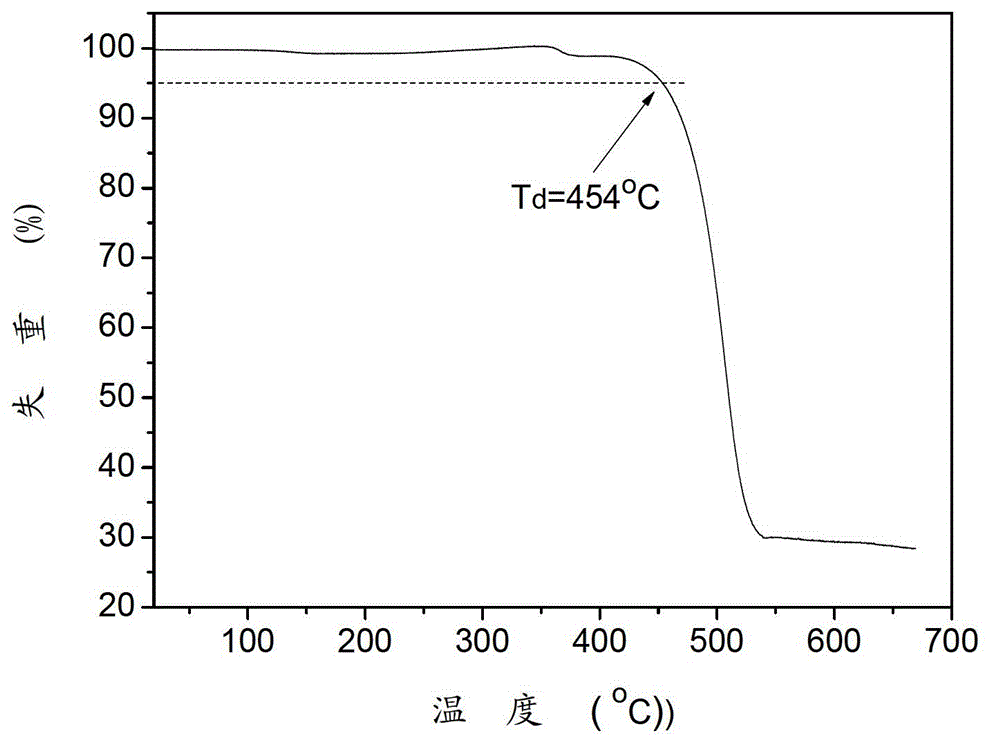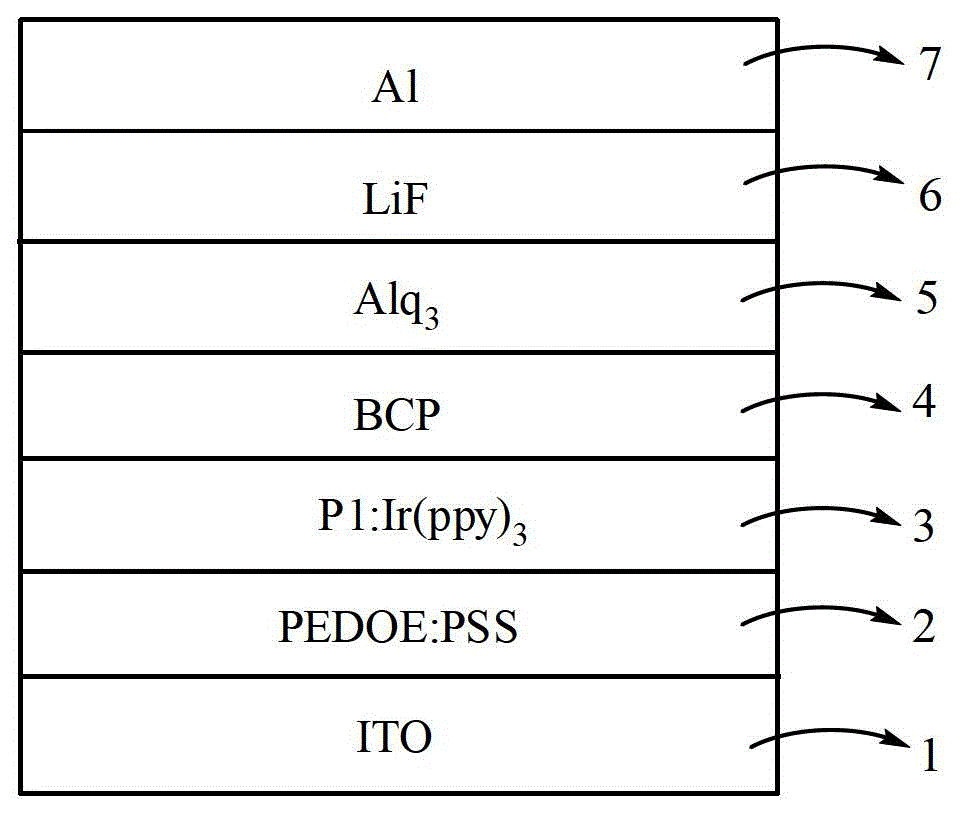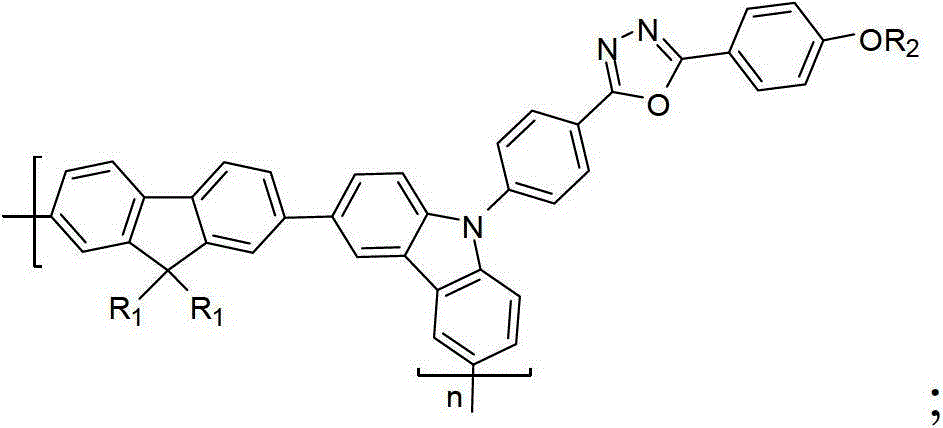Green-light copolymer material as well as preparation method thereof and organic light-emitting device
A copolymer and green light technology, applied in the direction of luminescent materials, electrical solid devices, electrical components, etc., can solve the problems of complex synthesis and harsh preparation conditions, and achieve the effects of cheap and easy raw materials, improved efficiency, and reduced process flow
- Summary
- Abstract
- Description
- Claims
- Application Information
AI Technical Summary
Problems solved by technology
Method used
Image
Examples
Embodiment 1
[0038] The green light copolymer material of this example, that is, poly{2,7-diyl-9,9-bis(n-hexyl)-9H-fluorene-co-2-(4-(2,7-diyl- 9H-carbazol-9-yl)phenyl)-5-(4-(n-hexyloxy)phenyl)-1,3,4-oxadiazole} (P1) (wherein, R 1 is n-hexyl, R 2 is n-hexyl, n=49), its structural formula is as follows:
[0039]
[0040] The preparation steps of above-mentioned polymer are as follows:
[0041] The reaction formula is as follows:
[0042]
[0043] Under argon protection, 2,7-dipinacol borate-9,9-bis(n-hexyl)-9H-fluorene (98mg, 0.2mmol), 2-(4-(2,7- Bis(pinacol borate)-9H-carbazol-9-yl)phenyl)-5-(4-(n-hexyloxy)phenyl)-1,3,4-oxadiazole (148mg, 0.2 mmol) into a flask filled with 10ml of toluene solvent, after fully dissolving, potassium carbonate (2mL, 2mol / L) solution was added into the flask, vacuumed to remove oxygen and filled with argon, and then added bistriphenylphosphine dichloride Palladium chloride (5.6mg, 0.008mmol); the flask was heated to 100°C for Suzuki coupling reaction...
Embodiment 2
[0047] The green light copolymer material of this embodiment, that is, poly{2,7-diyl-9,9-di(n-eicosyl)-9H-fluorene-co-2-(4-(2,7-di Base-9H-carbazol-9-yl)phenyl)-5-(4-(methoxy)phenyl)-1,3,4-oxadiazole} (P2) (wherein, R 1 is n-eicosyl, R 2 is methyl group, n=25), its structural formula is as follows:
[0048]
[0049] The preparation steps of above-mentioned polymer are as follows:
[0050] The reaction formula is as follows:
[0051]
[0052] Under the protection of a mixed gas of nitrogen and argon, 2,7-dipinacol borate-9,9-di(n-eicosyl)-9H-fluorene (266mg, 0.3mmol), (4-(2 ,7-bis(pinacol borate)-9H-carbazol-9-yl)phenyl)-5-(4-(methoxy)phenyl)-1,3,4-oxadiazole ( Add 201mg, 0.3mmol) and 15mL tetrahydrofuran into a 50mL two-necked bottle, fully dissolve, pass in a mixture of nitrogen and argon to exhaust the air for about 20min, and then add tetrakistriphenylphosphine palladium (4mg, 0.003mmol) into it , fully dissolved and then added sodium bicarbonate (3mL, 2mol / L) so...
Embodiment 3
[0055] The green light copolymer material of this embodiment, that is, poly{2,7-diyl-9,9-bis(methyl)-9H-fluorene-co-2-(4-(2,7-diyl-9H -carbazol-9-yl)phenyl)-5-(4-(n-eicosyloxy)phenyl)-1,3,4-oxadiazole} (P3) (wherein, R 1 is a methyl group, R 2 is n-eicosyl, n=100), its structural formula is as follows:
[0056]
[0057] The preparation steps of above-mentioned polymer are as follows:
[0058] The reaction formula is as follows:
[0059]
[0060] Under nitrogen protection, 2,7-dipinacol borate-9,9-bis(methyl)-9H-fluorene (105mg, 0.3mmol), (4-(2,7-bis(pinacol Borate)-9H-carbazol-9-yl)phenyl)-5-(4-(n-eicosyloxy)phenyl)-1,3,4-oxadiazole (309mg, 0.33mmol) , palladium acetate (3.5mg, 0.015mmol) and tris(o-methoxyphenyl)phosphine (21mg, 0.06mmol) were added to a flask containing 12mL of N,N-dimethylformamide, fully dissolved and then added Potassium carbonate (3mL, 2mol / L) solution, and then blow nitrogen into the flask to evacuate the air for about 30min; heat the flask t...
PUM
| Property | Measurement | Unit |
|---|---|---|
| thickness | aaaaa | aaaaa |
| thickness | aaaaa | aaaaa |
| thickness | aaaaa | aaaaa |
Abstract
Description
Claims
Application Information
 Login to View More
Login to View More - R&D
- Intellectual Property
- Life Sciences
- Materials
- Tech Scout
- Unparalleled Data Quality
- Higher Quality Content
- 60% Fewer Hallucinations
Browse by: Latest US Patents, China's latest patents, Technical Efficacy Thesaurus, Application Domain, Technology Topic, Popular Technical Reports.
© 2025 PatSnap. All rights reserved.Legal|Privacy policy|Modern Slavery Act Transparency Statement|Sitemap|About US| Contact US: help@patsnap.com



